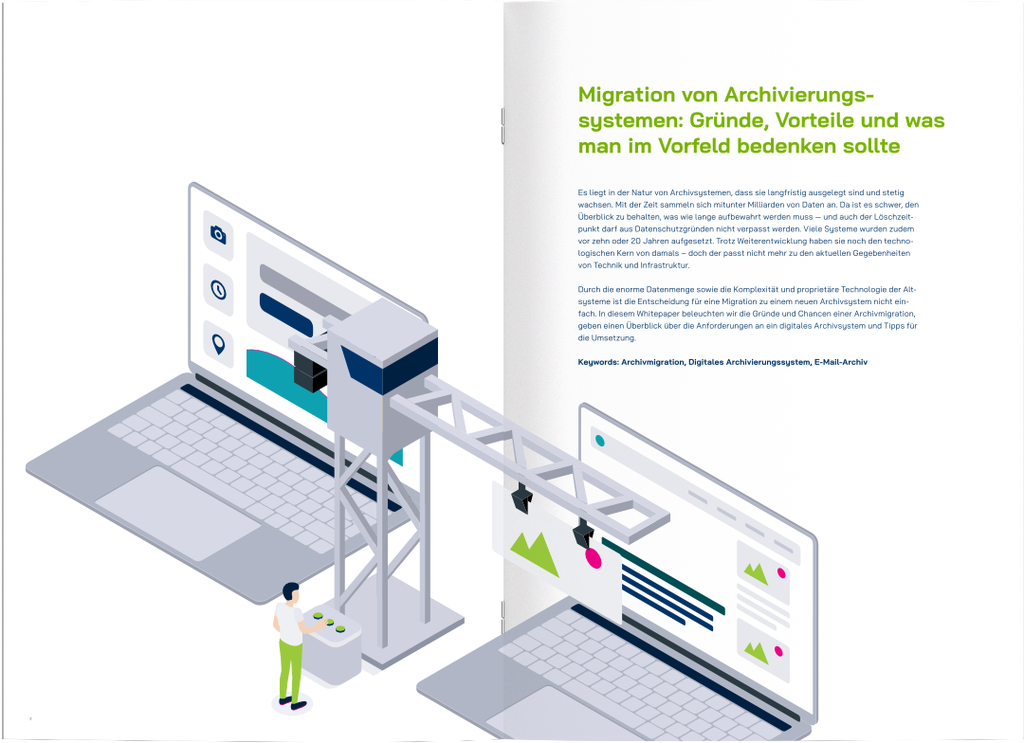

2 August 2021
It’s time for a change: New technology brings old archives up to speed
By Stephanie Schuldes
Rapidly growing databases, a confusing software landscape, and ever-changing legal requirements: At some point, the old document archive reaches its limit and needs to be replaced. We show you what a future-proof archiving system must be capable of.
Archiving systems are inherently designed for long-term storage. However, much has changed in the last 20 years. For one thing, data volumes must be processed on a completely different scale – old systems are incapable of doing so. New technologies, on the other hand, open up entirely new possibilities for handling data and developing long-term document management systems.
What issues can an old archiving system cause?
Anyone using an archiving system that was set up ten or twenty years ago is likely to face a number of issues by now:
- Because it is not scalable, the old archiving system cannot handle the rapidly increasing volume of data.
- Following a company takeover or merger, the two systems are incompatible.
- The manufacturer is no longer developing the system used up to this point, which can lead to incompatibilities and security risks.
- Due to technological advancements, the archiving system’s interfaces are no longer compatible with other applications used in the company.
- The old archiving system is no longer compliant with current legal requirements.
- The system is complex, unmanageable, difficult to service, and costly to operate and maintain.
There are plenty of reasons to make a change, if only it weren’t so risky and expensive. However, sticking with an old system limits the company’s ability to innovate. With serious ramifications: Because of the risk of incompatibility with other applications, modernization of the entire system landscape is becoming increasingly delayed. As a result, current technologies cannot be used, and the company falls behind the competition.
Future-proofing: If you’re going to change, do it right
Before switching to a new archiving system, it is best to put the entire document management system to the test. This includes technical, legal, and organizational considerations. As a result, an archiving concept is created that regulates responsibilities and access rights, as well as defines the form and structure of the data to be archived.
System migration is unquestionably a time-consuming task. To avoid it as much as possible, it is worthwhile to invest in a system that can grow with the company and adapt to future needs. The following factors should be taken into account:
Scalability: The system must grow with the data in order to provide enough space for all content requiring archiving in ten to fifteen years. This should be accomplished through the use of future-proof technologies such as microservices and container-based architectures.
Platform independence: The use of open standards increases the likelihood that the system will remain executable and integrable in the future. Because the specifications are freely available, many vendors can create applications based on them. Existing building blocks and protocols facilitate application development while also improving interoperability and portability. Because the standards are widely known, there are more qualified developers available. Furthermore, data formats and interfaces are not vendor-specific and can be read by future applications.
Cost management: Aside from the current maintenance costs, it is critical that the system has a long-term perspective, so that the next change is not due in just three years.
Modernize digital archiving systems now

- Why should you migrate now?
- What are internal and external factors influencing migration?
- What belongs in the archiving concept?
- What requirements must the archiving system meet?
- Important tips for implementing the migration
- Successful case studies
Archiving in the 21st century with content services
yuuvis® Momentum by OPTIMAL SYSTEMS is an example of such a system. It is intended for use in the development of professional content and information management solutions. It manages datasets of any size with metadata – including billions of binary documents in any file format – and provides a fast full-text search. yuuvis® Momentum is built on microservices implemented with Docker containers and orchestrated with Kubernetes – the state-of-the-art for cloud platforms. It runs on any system that supports Kubernetes, including on-premises computers, private or public cloud services, and hybrid scenarios.
Conclusion: What are the benefits of using a modern archiving system?
A modern archiving system provides peace of mind because it:
- grows with the amount of data and users;
- integrates seamlessly into the existing system landscape thanks to future-proof technology, platform independence, and compatible interfaces;
- saves money by using open source technologies instead of proprietary databases and servers;
- simplifies the system landscape by using only the components required by the company;
- assists with compliance by adhering to legal requirements for retention, deletion, and access restriction.
You might also like
Do you have any further questions?
Get in touch with us!



